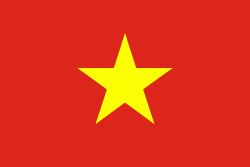Phú Quốc (Huyện Phú Quốc)
Phú Quốc is the largest island in Vietnam. Phú Quốc and nearby islands, along with the distant Thổ Chu Islands, are part of Kiên Giang Province as Phú Quốc City, the island has a total area of 574 sqkm and a permanent population of approximately 179,480 people. Located in the Gulf of Thailand, the island city of Phú Quốc includes the island proper and 21 smaller islets. Dương Đông ward is located on the west coast, and is also the administrative and largest town on the island. The other ward is An Thới on the southern tip of the island.
Its primary industries are fishing, agriculture, and a fast-growing tourism sector. Phú Quốc has achieved fast economic growth due to its current tourism boom. Many infrastructure projects have been carried out, including several five-star hotels and resorts. Phú Quốc International Airport is the hub connecting Phú Quốc with mainland Vietnam and other international destinations.
From March 2014, Vietnam allowed all foreign tourists to visit Phú Quốc visa-free for a period of up to 30 days. By 2017, the government of Vietnam planned to set up a Special Administrative Region which covered Phú Quốc Island and peripheral islets and upgrade it to a provincial city with special administration.
The historical Phú Quốc Prison was based here; the prison was built by French colonialists to detain captured Viet Cong and North Vietnamese soldiers.
Phú Quốc lies south of the Cambodian coast, south of Kampot, and 40 km west of Hà Tiên, the nearest coastal town in Vietnam. Roughly triangular in shape the island is 50 km long from north to south and 25 km from east to west at its widest. It is also located 17 nmi from Kampot, 62 nmi from Rạch Giá and nearly 290 nmi from Laem Chabang, Thailand. A mountainous ridge known as "99 Peaks" runs the length of Phú Quốc, with Chúa Mountain being the tallest at 603 m.
Phú Quốc Island is mainly composed of sedimentary rocks from the Mesozoic and Cenozoic age, including heterogeneous conglomerate composition, layering thick, quartz pebbles, silica, limestone, rhyolite and felsite. The Mesozoic rocks are classified in Phú Quốc Formation (K pq). The Cenozoic sediments are classified in formations of Long Toàn (middle - upper Pleistocene), Long Mỹ (upper Pleistocene), Hậu Giang (lower - middle Holocene), upper Holocene sediments, and undivided Quaternary (Q).
Its primary industries are fishing, agriculture, and a fast-growing tourism sector. Phú Quốc has achieved fast economic growth due to its current tourism boom. Many infrastructure projects have been carried out, including several five-star hotels and resorts. Phú Quốc International Airport is the hub connecting Phú Quốc with mainland Vietnam and other international destinations.
From March 2014, Vietnam allowed all foreign tourists to visit Phú Quốc visa-free for a period of up to 30 days. By 2017, the government of Vietnam planned to set up a Special Administrative Region which covered Phú Quốc Island and peripheral islets and upgrade it to a provincial city with special administration.
The historical Phú Quốc Prison was based here; the prison was built by French colonialists to detain captured Viet Cong and North Vietnamese soldiers.
Phú Quốc lies south of the Cambodian coast, south of Kampot, and 40 km west of Hà Tiên, the nearest coastal town in Vietnam. Roughly triangular in shape the island is 50 km long from north to south and 25 km from east to west at its widest. It is also located 17 nmi from Kampot, 62 nmi from Rạch Giá and nearly 290 nmi from Laem Chabang, Thailand. A mountainous ridge known as "99 Peaks" runs the length of Phú Quốc, with Chúa Mountain being the tallest at 603 m.
Phú Quốc Island is mainly composed of sedimentary rocks from the Mesozoic and Cenozoic age, including heterogeneous conglomerate composition, layering thick, quartz pebbles, silica, limestone, rhyolite and felsite. The Mesozoic rocks are classified in Phú Quốc Formation (K pq). The Cenozoic sediments are classified in formations of Long Toàn (middle - upper Pleistocene), Long Mỹ (upper Pleistocene), Hậu Giang (lower - middle Holocene), upper Holocene sediments, and undivided Quaternary (Q).
Map - Phú Quốc (Huyện Phú Quốc)
Map
Country - Vietnam
 |
 |
| Flag of Vietnam | |
Vietnam was inhabited by the Paleolithic age, with states established in the first millennium BC on the Red River Delta in modern-day northern Vietnam. The Han dynasty annexed Northern and Central Vietnam under Chinese rule from 111 BC, until the first dynasty emerged in 939. Successive monarchical dynasties absorbed Chinese influences through Confucianism and Buddhism, and expanded southward to the Mekong Delta, conquering Champa. The Nguyễn—the last imperial dynasty—surrendered to France in 1883. Following the August Revolution, the nationalist Viet Minh under the leadership of communist revolutionary Ho Chi Minh proclaimed independence from France in 1945.
Currency / Language
| ISO | Currency | Symbol | Significant figures |
|---|---|---|---|
| VND | Vietnamese đồng | ₫ | 0 |
| ISO | Language |
|---|---|
| KM | Central Khmer language |
| ZH | Chinese language |
| EN | English language |
| FR | French language |
| VI | Vietnamese language |















